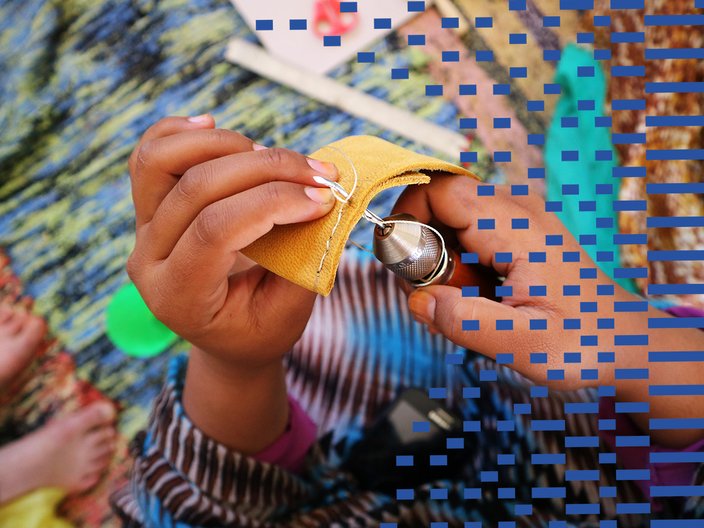
Sandra Fruebing
14 August 2019
The Crafting Futures Grant Scheme is now open for applications. We held live Q&A sessions on 25 July and 28 August to tell applicants more about the grant, what we're looking for and to answer questions.
If you were unable to join either session, you can view the recording for 25 July here and 28 August here.
You can learn more about the grant scheme through our blog post and downloadable open call document here.
From your emails and through the live Q&A's, we're pleased to have prepared some responses to Frequently Asked Questions below.
If you have a specific question after reviewing these resources, get in touch with kendall.robbins@britishcouncil.org. We look forward to hearing your questions and helping you create some brilliant proposals.
FAQs
What can I pay for with the grant?
The grant can cover any costs that allow you undertake the project. This can include travel, fees, contributions to other collaborators, data collection for evaluation, translation, etc. Previously grant recipients have spent the grant on commissioning a filmmaker to produce their final output, take language lessons ahead of their travel, or cover their artist fees. It’s really important that the budget is realistic for what you are proposing.
We also suggest that you include details of any in-kind support you may be receiving, such as someone waiving a fee, providing a cash donation, or giving you free accommodation. This way we can get a clear idea of whether your budget is realistic.
A list of possible costs are included on page 7 of the open call document here
What kind of projects happened last year?
Last year we awarded 8 grants for projects happening in China, the Democratic Republic of the Congo, Egypt, Georgia, Pakistan, Panama, the Philippines and Ukraine. Grantees included makers, designers and academics, and they collaborated with communities, universities, NGOs, local collectives and arts organisations. They ranged from projects focused on women's empowerment to craft as a tool to address climate change to culture-based design to youth engagement. Outputs included toolkits, films, podcasts, exhibitions, process diagrams, objects and academic publications.
We are in the process of sharing outputs from the past year via our website, which can be found on our Crafting Futures Grant Scheme page. We're also inviting last year's grantees to present their projects at a briefing event on 30 October in London. Keep an eye out on our website for more details.
Will you support existing collaborations or ongoing projects?
Yes. We are keen to see projects which demonstrate a meaningful collaboration, and this might come through an existing collaboration or partnership, though this is not a requirement.
If you are applying with an existing partner, try to address how this opportunity will build on this existing relationship and expand your overseas connections. In the selection criteria, evaluators will consider whether this project could happen without the support of the grant scheme and whether it will enhance your personal practice and international networks.
If you are applying with an ongoing project, also think about this selection criteria as well as ensuring it responds to the aims of the grant and Crafting Futures.
Full selection criteria is available on page 8 of the open call document here
Can I submit more than one application?
Yes. We currently have no criteria that says you cannot. It would also be fine to be named in multiple applications.
Can an application be from multiple people?
Absolutely. We are open to applications which come from individuals, small organisations or collectives of practitioners. Just ensure that what is being proposed is realistic within the budget and time frame.
Will this scheme run again?
This is the second year of the scheme, and we are currently planning on a third year which will launch in summer 2020.
Is there a preferred length of time for overseas visits and travel?
There is no advised time. Our advice is to be realistic in terms of the budget and the ambition of the project as once the grant is provided it cannot be increased and the project described within the proposal must be delivered according to the contract. In the activities last year we had grantees go for longer because they were able to get in-kind accommodation from their collaborator, and others who only went for a week. We also had some applicants who chose to provide their artist/practitioner costs in-kind in order to make for a bigger budget, whereas others chose to cover their artist costs through the grant. Neither approach impacted the decision on their applications and is not part of the selection criteria. We are more concerned with whether it is realistic, and we would rather see smaller scale activity which is achievable.
What should be included in the letter of endorsement from my collaborator?
They should include information about how they will work with you and why they feel it is relevant to their context and practice, why they want it to happen, anything they’re doing to support, etc. The letter should demonstrate that there will be a meaningful partnership and collaboration and that it is useful.
It may also be possible for your collaborator to submit this endorsement in a different format if writing a letter is not suitable for them, such as a film clip. Do get in touch if there are concerns about your collaborator’s ability to provide a letter due to language or literacy limitations.
I want to apply to a country which is not on the ODA list. Is that OK?
Yes. The scheme is weight towards countries on the ODA list, but we have non-ODA grants as well. We anticipate awarding up to 6 grants to ODA countries and up to 2 grants to all other countries.